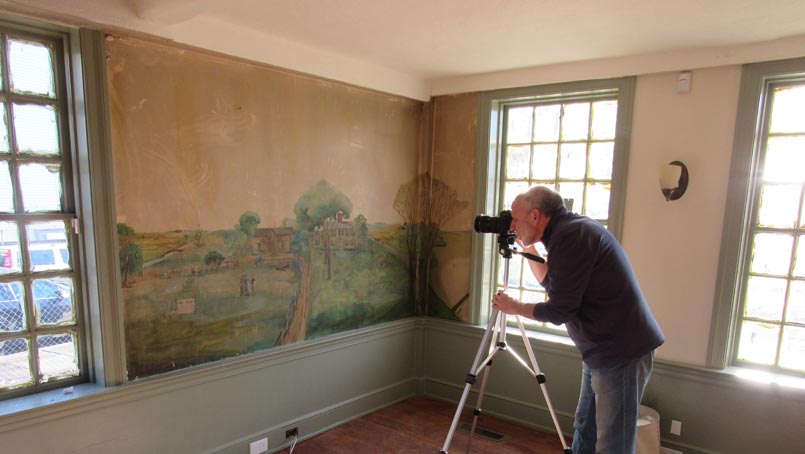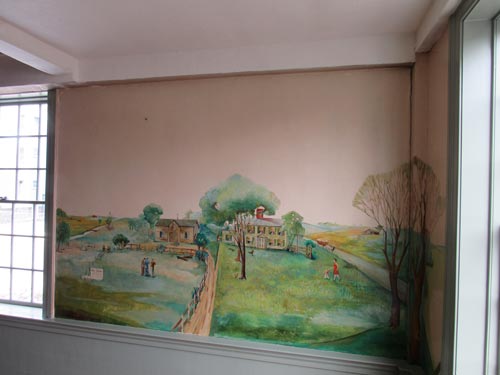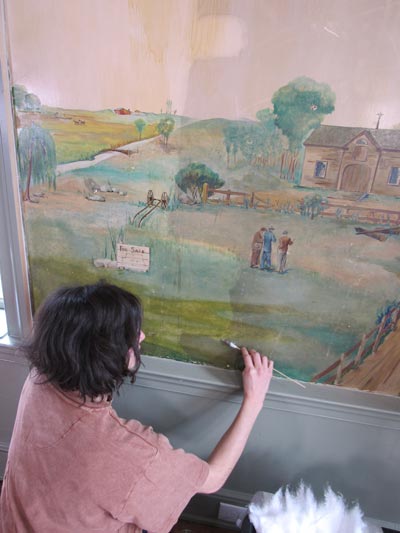
26 Mar Artist Kay Gerson’s Murals at the Fowler Clark Farm are Restored
One of the most intriguing elements of the Fowler Clark Epstein Farm are the two murals painted in one of the first floor rooms of the historic farmhouse. The murals were unsigned, but we learned from Walter Santory, a former employee of Jorge Epstein, that the murals were painted by another long time Epstein employee, Kay Gerson.

One of the murals depicts an imaginary, pastoral view of the farm in summer as it might have looked in centuries past before the more rural Dorchester became part of Boston in 1872. There’s a “For Sale” sign in the front yard, and a few men that appear to be dressed in 1940s attire look as though they might be striking a deal (the Epstein family bought the property in 1941). A woman and child, also dressed in 1940s clothing, are in the front yard, and an ox and cart are shown at the right. By the 1940s, the neighborhood had been fully developed with multifamily housing, so the image is clearly more fantasy than reality.
The second mural in the room was unfortunately never completed. It appears to show the farm in winter, but more notably, the interior of the house is on fire. Pencil sketches show a few men that appear to be chatting calmly in front of the house – one wearing a fireman’s helmet, another wearing overalls. Preliminary sketches also show a fire engine approaching and a few men pulling a hose toward the house. We did find evidence of a fire in charred beams of the houses’ upper story during construction. However, we don’t know why this mural was never completed, and what story it is telling of the house’s past.
 With the rehabilitation of the farmhouse nearing completion, HBI hired conservator Gianfranco Pocobene (who is the Chief Conservator at the Isabella Stewart Gardner Museum) to oversee the restoration of the murals. Primarily this meant carefully cleaning many years’ worth of soot and grime from the surface, then removing streaky varnish that had discolored the completed mural. Conservation Technician Peggy Waldron and two other technicians worked carefully to meticulously clean the murals with a mild detergent – diamonium citrate. It was particularly challenging to remove the dirt from the unfinished mural without also removing the pencil sketches. A light clear varnish was places on the cleaned murals to protect them.
With the rehabilitation of the farmhouse nearing completion, HBI hired conservator Gianfranco Pocobene (who is the Chief Conservator at the Isabella Stewart Gardner Museum) to oversee the restoration of the murals. Primarily this meant carefully cleaning many years’ worth of soot and grime from the surface, then removing streaky varnish that had discolored the completed mural. Conservation Technician Peggy Waldron and two other technicians worked carefully to meticulously clean the murals with a mild detergent – diamonium citrate. It was particularly challenging to remove the dirt from the unfinished mural without also removing the pencil sketches. A light clear varnish was places on the cleaned murals to protect them.
The result of their work is quite amazing. The colors of the completed mural are bright and vibrant, and details we never noticed before can now be seen. We’re looking forward to showing everyone the completed, restored murals at our ribbon cutting in June.



